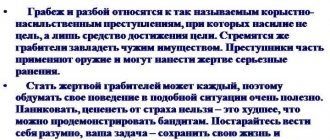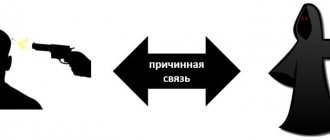Robbery is an intentional offense classified by the Criminal Code as a crime against property.
One of the main signs of robbery is the use of violence against the victim.
It is necessary to distinguish between completed robbery and attempted murder, since the severity of the punishment depends on this.
Subject, object, subjective and objective side
Robbery refers to crimes with a truncated composition.
The moment the robbery ends is the moment the victim is attacked for the purpose of stealing someone else’s property, committed with the use of violence dangerous to life or health, or with the threat of such violence (the robbery ends from this moment).
Reference.
Truncated compositions are considered completed from the moment the first of the elements of the objective side is completed. To recognize a crime with a truncated element as completed, the occurrence of a criminal result is not required; it is not even necessary to complete the actions that lead to the occurrence of such a result.
Material offenses are characterized by the fact that the moment of completion of such crimes is associated with the onset of socially dangerous consequences, and the consequences are not included in the description of the objective side of formal offenses, and this description is limited to an indication of the commission of certain actions.
The composition of robbery can be presented as follows (concepts and characteristics of the composition):
- An object.
This crime has two objects: property relations and relations to protect personal integrity. Optional objects: life, health, inviolability of home.
- Objective side.
The objective side is an attack that is accompanied by physical violence or the threat of it (mental violence).
Such violence must be dangerous to life and health, and the attack itself must be aimed at taking possession of someone else’s property.
- Subject.
The general subject of robbery is a sane individual who has reached 14 years of age (Part 2 of Article 20 of the Criminal Code of the Russian Federation).
- Subjective side.
The subjective side is expressed in the form of direct intent. An optional feature of the subjective side is the goal. The purpose of robbery must be selfish. Thus, if the attack was for a completely different purpose, unrelated to the intent to steal, the qualification under Article 162 is excluded.
Recommended reading:
The difference between robbery and other related compounds
Commentary to Art. 162 of the Criminal Code of the Russian Federation (Robbery)
What types of robbery exist?
What is the article for robbery?
In Art. 162 of the Criminal Code of the Russian Federation establishes the following types of offenses of robbery:
- with the absence of qualifying characteristics (simple). In this case, the following types of punishment may be applied:
- involvement in forced labor for a period of up to 5 years;
- imprisonment for up to eight years (with or without penalties of up to 500 thousand rubles);
At what point is it considered completed?
Robbery is a crime with a truncated composition. This means that, in contrast to material and even formal compositions, the moment of the end of the truncated composition is moved to an earlier stage than the onset of consequences.
To recognize a crime with a truncated composition as completed, the occurrence of a criminal result is not required. It is not even necessary to complete the actions that lead to such a result.
Important! The moment of the end of the robbery is the moment of attack on the victim for the purpose of stealing someone else's property, committed with the use of violence dangerous to life or health, or with the threat of such violence.
It does not matter whether the person succeeded in taking possession of the property. And if it failed, then for what reason: did he suddenly change his mind, did the victim resist?
After the moment of the attack, voluntary refusal is impossible , and all other of the above circumstances will not affect the qualification, since the act is recognized as a completed crime.
There is a fundamental difference between robbery and other forms of theft: theft and robbery are considered completed crimes at the moment when the person has the opportunity to dispose of the stolen property. This means that until the person leaves the victim’s apartment from which he stole property, the crime will not be completed.
- If at this moment law enforcement officers enter the apartment and detain the suspect, he can only be charged with attempted theft (or robbery, if the victim was in the apartment and saw how they were trying to steal his property).
- If the victim was attacked with life-threatening violence, then it no longer matters whether the person managed to leave the apartment with the stolen property or whether the police officers entered the room at the moment when something was just being snatched from the victim’s hands . In this case, the robbery will end from the moment of the attack (clause 6 of the PPVS No. 29 “On judicial practice in cases of theft, robbery and robbery”).
Main types of robbery
When classifying robbery, the degree of severity, the number and age of persons participating in the commission of the illegal act, and the presence of weapons are taken into account.
When considering a case by investigative authorities and then by courts, the above factors are taken into account, as well as the conditions and features of the case. The most common types of robbery are:
- Property.
This type is characterized by a lesser degree of rigidity towards the victim. When committing property robbery, physical violence is not intended, since such a crime is committed for the purpose of enrichment.
- Armed.
Robbery is classified as armed robbery even without the use of weapons during the attack. Based on judicial practice, if there are weapons, it is assumed that criminals could use them. A weapon is also considered any object (stones, bottles, pipes, bats), the use of which can cause injury to the victim.
- Entering into private territory.
It could be an apartment, house, office, store, warehouse. This fact is considered an aggravating circumstance, which is taken into account when determining the punishment. If such a crime is committed, a more severe sanction is envisaged.
Note! Robbery attacks in which murders are committed are distinguished by the greatest degree of severity and the application of the maximum punishment to the offender in conjunction with Art. 105 of the Criminal Code of the Russian Federation.
Depending on the conditions under which the attack was committed, crimes are of the following types:
- Robbery on the roads.
Such crimes are committed with the aim of seizing funds belonging to the driver or a vehicle.
- An attack by an organized criminal group by prior conspiracy.
When committing such crimes, weapons may be used, and the victim is also often killed.
- Robbery on maritime transport.
If such a crime is committed, theft on a large scale is possible, as well as disruption of the operation of shipping routes. The damage caused is taken into account when the court makes a verdict.
Punishment and result of the crime
In Art. 162 of the Criminal Code of the Russian Federation provides for harsh measures in the form of imprisonment for a term of up to eight years in the event of committing even a simple offense.
Depending on the severity and specificity of the crime, the following penalties may be applied:
- forced labor for up to five years, as well as imprisonment for up to eight years and a fine of 500 thousand rubles. (or the amount of earnings over the last three years) if violence was committed or the offender threatened violence;
- imprisonment for up to ten years and a fine of up to 1 million rubles when committing a crime as part of an organized group or using weapons;
- imprisonment for a term of 7 to 12 years and a fine of up to 1 million rubles. for illegal entry;
- imprisonment for a term of 8 to 15 years and a fine, the amount of which can be up to 1 million rubles, for causing grievous harm to health, especially large damage.
What is robbery
Robbery is discussed in Article 161 of the Criminal Code of the Russian Federation. Robbery is open theft. It is committed in the presence of the owner (possessor) of the thing that the criminal is encroaching on, or in full view of strangers. At the same time, the robber realizes that those present during the robbery understand the illegality of his actions. The presence of attempts by others to stop the criminal and stop illegal actions does not matter for the qualification of the act.
Robbery contains:
- the object of the crime is property rights. The subject of robbery is movable property of a certain value;
- the subject of the crime is a sane individual who was 14 years old at the time of the crime;
- the subjective side - the direct intent of the criminal and the presence of self-interest, awareness of the openness of the method of committing theft;
- the objective side is the unconcealed actions of the criminal at the time of the robbery, the possible use of violence (threats of its use). The injured party bears real damage in connection with the robbery that occurred.
Note! Robbery is considered a completed crime if the property is confiscated and the criminal uses it (has the opportunity to use it) at his own discretion.
Attempted robbery: concept and distinctive features
Robbery has a subjective and objective side. Subjective signs are the criminal’s selfish motives to take possession of someone else’s property.
An integral element of robbery as a form of theft and its objective side is violence against the victim. Moreover, the main goal of criminals is the theft of property, and violence is not an end in itself of robbery, but only a means for its implementation. The aggressive behavior of a criminal only simplifies the task of taking possession of someone else's property.
A crime can be classified as an attempt if its main goal was never achieved.
There is no clear position among lawyers on whether it is possible to talk about attempted robbery. This question can be considered in two positions:
- When an attack during robbery is equated to violence, it turns out that attempted robbery, logically, is impossible. In this case, we may not be talking about an assassination attempt, but about preparation for robbery.
- If the attack is assessed as an independent action of the objective side of this type of theft and is not equated with violence, then we can talk about attempted robbery.
Practice of application of Article 162 of the Criminal Code of the Russian Federation
Each robbery case is unique and contains its own individual characteristics that affect the final sentence. Let's look at some real examples.
A resident of Ulyanovsk committed a robbery at a jewelry store, during which he seized more than 80 jewelry totaling about 250 thousand rubles. To implement his criminal plan, the subject used a hammer as a weapon. The court found the man guilty of committing a crime under Part 3 of Article 162 of the Criminal Code of the Russian Federation and sentenced him to 8 years in a maximum security colony. In addition, the person at fault must compensate the store for the damage.
Here is a case where the court imposed a suspended sentence:
A 16-year-old resident of the Voronezh region, in a state of alcoholic intoxication, tried to forcefully snatch a bag from his friend, threatening him with an ax. However, the plan could not be accomplished, and the teenager fled the crime scene. The citizen appeared in court only 2 years later. The court sentenced the subject to a suspended sentence of 3 years, taking into account the abundance of mitigating circumstances.
It should be remembered that most often robbery is committed in conjunction with other crimes - rape, illegal possession of firearms, etc., which, naturally, increases the final punishment.
Read more about the differences
- Danger to life and health is the indicator by which the distinction is made in the first place. If the violent methods used by the criminal at the time of the crime were dangerous, then even if life and health were not harmed as a result, this is robbery. If the harm caused by the criminal did not affect his ability to work, there were no consequences, or there were consequences, but they passed quickly enough, then this is violent robbery.
- Threats can be identified as a separate item, as mental violence.
According to the Criminal Code of the Russian Federation and Resolution of the PVS of the Russian Federation No. 29, if threats of violence pose a danger to life and health, then this is robbery, and if they clearly do not, then violent robbery. However, in practice it is difficult to determine where the line lies. The judge must decide this question, taking into account the place and time of the crime, the number of criminals, whether the victim had the opportunity to call for help, and also how real the threat seemed to him. If it was not life-threatening, but was perceived as such by the victim, then the crime is considered robbery, if the offender expected that the threat would be considered real. But if the actions of the criminal after such a threat indicate that he did not want to carry out the threat, then this is classified as violent robbery. - The end of the crime is the next point. The robbery is considered completed at the moment when the criminal can use the stolen property (read more about when a robbery is considered completed, read here). In the case of robbery, assault is considered a means of stealing property. The robbery is over the moment violence is committed, regardless of whether property was stolen as a result or not.
- Responsibility for robbery and non-violent robbery is also different.
Differences in penalties
The terms of forced labor for violent robbery and robbery are the same. But the term of imprisonment and the fine for robbery are longer. For robbery with aggravating circumstances, forced labor is not given, but the term of imprisonment and the fine increase.
Main differences
| Violent robbery | Robbery | |
| Danger to life and health. | Not dangerous to life and health | Dangerous to life and health. (Even potentially while committing a crime) |
| Threats | Threats of violence that are clearly not dangerous to life and health, but only if the victim realizes this. If a robber threatens with a fake pistol or other weapon, but the victim considers the threat to be real, then the crime can be classified as robbery. (According to the resolution of the RF PVS No. 29) | Threats of violence dangerous to life and health. |
| The moment from which the crime is considered completed. | When the criminal has a real opportunity to use the stolen property. | When the criminal begins to commit illegal actions (commits an attack). Because then the encroachment is primarily on the life and health of a person, and only then on his property. |







